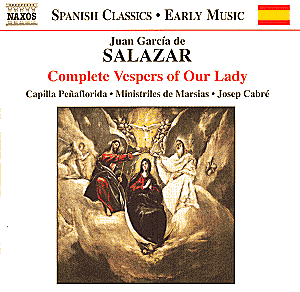Juan
García DE SALAZAR (1639
- 1710)
Complete Vespers of Our Lady
Juan García DE SALAZAR
(Entrada) Regina coeli (instr) [00:31]
plainchant
(Invitatorio) Deus in adiutorium - Domine
ad adiuvandum me [00:51]
(Antifona) Dum esset [00:45]
Juan García DE SALAZAR
(Salmo 109) Dixit Dominus [04:44]
(Motete) Quae es ista [04:11]
García
DE OLAGÜE (c1700)
Verso de clarín I (organ) [00:58]
plainchant
(Antiphona) Laeva ejus [00:35]
plainchant/García DE OLAGÜE
(Salmo 112) Laudate pueri Dominum (alternatim)
[03:05]
Juan García DE SALAZAR
(Motete) O gloriosa virginum [03:08]
plainchant
(Antiphona) Nigra sum [00:42]
Juan García DE SALAZAR
(Salmo 121) Laetatus sum [05:08]
(Motete) Sub tuum praesidium [03:04]
Da pacem, Domine (instr]
plainchant
(Antiphona) Jam hiems transiit [00:35]
plainchant/García DE OLAGÜE
(Salmo 126) Nisi Dominus (alternatim)
[02:18]
Tomás Luis
DE VICTORIA (1548-1611)/arr
Juan García DE SALAZAR
(Motete) Vidi speciosam [04:07]
García DE OLAGÜE
Verso de clarín II (organ) [00:41]
plainchant
(Antiphona) Speciosa facta es [00:33]
Juan García DE SALAZAR
(Salmo 147) Lauda, Jerusalem, Dominum
[04:44]
Veni, sponsa Christi (instr]
(Himno) Ave, maris stella [04:48]
José XIMÉNEZ
(1601 - 1672)
Batalla de 6° tono (organ) [04:34]
Juan García DE SALAZAR
(Antiphona) Sancta Maria, succurre miseris
[03:42]
(Cántico B.V.M.) Magnificat [06:19]
plainchant
Benedicamus Domino [00:45]
Juan García DE SALAZAR
(Salve en romance) Salve Reina de los
cielos [03:41]
Capilla Peñaflorida, Ministriles
de Marsias/Dir: Josep Cabré
Recorded in December 2000 at Villabuena,
Spain DDD
NAXOS 8.555907 [69:16]
‘Officium
et Missa pro Defunctis’
In exequiis
plainchant
(Antiphona) Exsultabunt Domino/
(Psalmus 50) Miserere mei Deus [01:36]
Juan García DE SALAZAR
(Responsorium) Subvenite - (Versets)
Suscipiat te - Requiem aeternam [05:01]
plainchant
(Antiphona) In paradisum [01:19]
Ad matutinum
Juan García DE SALAZAR
(Invitatorium) Regem cui omnia vivunt/
(Psalmus 94) Venite exsultemus Domino
(10:07]
plainchant
(Antiphona) Dirige, Domine Deus meus
[00:22]
Juan García DE SALAZAR
(Psalmus 8) Verba mea auribus [01:34]
plainchant
(Antiphona) Convertere Domine [00:29]
Juan García DE SALAZAR
(Psalmus 6) Domine, ne in furore tuo
[02:21]
plainchant
(Antiphona) Nequando rapiat [00:30]
Juan García DE SALAZAR
(Psalmus 7) Domine Deus meus [01:55]
Pablo BRUNA (1611-1679]
Tiento de falsas de 2° tono (organ)
[06:01]
Ad missam
Juan García DE SALAZAR
(Introitus) Requiem aeternam/
(Psalmus) Te decet hymnus Deus [03:49]
Kyrie eleison [03:24]
(Graduale) Requiem aeternam - (Verset)
In memoria aeterna [04:13]
(Offertorium) Domine Jesu Christe -
(Verset) Hostias et preces [05:36]
Sanctus - Benedictus [02:07]
Francisco Corréa
DE ARAUXO (1576-1654)
Tiento de 4° tono (organ) [06:30]
Juan García DE SALAZAR
Agnus Dei [01:56]
(Communio) Lux aeterna [02:01]
plainchant
(Versiculum) Requiescat in pace. Amen
[00:20]
Juan García DE SALAZAR
(Motetus) O mors, quam amara est [04:06]
Absolutio post missam
[Responsorium) Libera me, Domine [08:00]
Capilla Peñaflorida/Dir: Josep
Cabré
Recorded in January 2004 at the Office
of the Symphony Orchestra of Euskadi,
Donostia (San Sebastian, Spain]
K617 - K617162 [72:52]
It doesn't happen that
often that two recordings are devoted
to an unknown composer and are released
at about the same time. This honour
has been conferred upon the Spanish
composer Juan García de Salazar,
who rates not even a mention in the
New Grove.
He was born near Burgos
and in 1660 became vice-principal of
the choir school in Burgos. The largest
part of his life he spent in Zamora
in Castile, first as 'maestro de capilla'
in the collegiate church, then - after
a couple of years at the cathedral of
Burgo de Osma - as 'maestro de capilla'
of Zamora Cathedral. The fact that he
stayed there from 1668 until his death
is rather unusual, as musicians often
went from one position to another in
order to increase their income. But
it seems that he wasn't that much interested
in the material part of life. And he
was also well respected and treated
by the bishop and the chapter. The musical
environment in which he worked were
stimulating enough to keep him in Zamora.
These recordings present
two characteristic examples of liturgical
music as it was composed in large quantities
during the 16th and 17th centuries.
Only relatively seldom did composers
write the music for complete services.
As the tracklist shows performers who
want to present liturgical music in
its context, need to look elsewhere
to fill in the missing parts.
The most obvious source
from which to fill the lacunae is plainchant,
as is the case here. And since it was
common practice to play instrumental
music during service, and nothing of
that kind is known from De Salazar,
pieces by contemporaries have been chosen
to give an idea of its use in liturgy.
It is important to emphasize that most
recordings of liturgical music are largely
speculative, as in both these recordings.
Generally I am all
in favour of performing and recording
music by forgotten masters of the past.
As De Salazar obviously held an important
position in his time, and was well respected
by his contemporaries, it is certainly
justified to present recordings with
his music, if only for historical reasons.
But not all music is of the highest
order. De Salazar's music is rather
average in quality. I am not saying
that his music is boring, but there
is little which catches the attention;
he repeats himself a little too often.
In the vesper music, for instance, the
technique of a phrase first sung by
a solo voice and then repeated by the
choir is applied too frequently.
De Salazar composed
his music for the Office of the Dead
in order gradually to replace the previously
used Missa pro defunctis by Guerrero.
But as with his Vesper music there is
a lack of variety here. It is too much
of the same. And although Requiem music
is mostly rather sombre, parts of the
liturgy strike a much more positive
note, like the Sanctus of the Mass and
Psalm 94 (Venite exultemus - O come,
let us sing unto the Lord). Here it
is all far too gloomy.
It has to be said,
though, that the performances don't
really help to convince the listener
that De Salazar is a forgotten master.
In the liner notes for the Officium
and Mass for the Dead Manuel
Sagastume writes that De Salazar's music
reflects the aesthetic characteristics
of the baroque and that he can be placed
close to Giacomo Carissimi. But the
performances don't reveal that convincingly.
There is a general lack of contrast
and the approach is rather subdued and
sometimes even bland. The performance
of the plainchant is too slow and stately.
The overall quality
of the singers and instrumentalists
is satisfying, although some singers
in the Vesper recording produce a slight
vibrato. More impressive here are the
wind players of the ensemble Ministriles
de Marsias.
To sum up: these recordings
are recommendable from a historical
point of view, but I don't think there
is real need to record a lot more of
De Salazar's oeuvre, unless the likes
of Savall, Lopez Banzo or McCreesh are
to get involved.
Johan van Veen


![]() Capilla Peñaflorida, Ministriles de Marsias/Dir:
Josep Cabré
Capilla Peñaflorida, Ministriles de Marsias/Dir:
Josep Cabré ![]() NAXOS 8.555907 [69:16]
NAXOS 8.555907 [69:16] ![]() Capilla Peñaflorida/Dir: Josep Cabré
Capilla Peñaflorida/Dir: Josep Cabré
![]() K617 - K617162 [72:52]
K617 - K617162 [72:52] 





